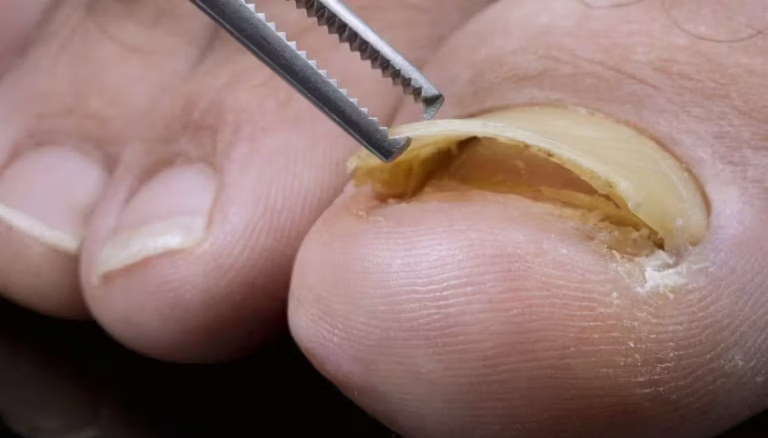Noticing a toe nail is falling off can be worrying, especially if you weren’t aware of an injury. Whether you’ve discovered a falling off toenail, a toenail came off suddenly, or your foot nails are falling off for no obvious reason, it’s important to understand what’s normal, what’s not, and when to seek professional care.
At ModPod Podiatry, we see many patients concerned about toenails dropping off, and while it can look dramatic, the underlying cause is often treatable when addressed early.
In this article, we’ll explain why toenails fall out, the most common causes, how to manage the issue safely at home, and when you should book in with a podiatrist.
What Does It Mean When a Toenail Is Falling Off?
When a nail comes off a toe, it’s usually due to a process called onycholysis—where the nail separates from the nail bed. This can happen slowly over weeks or suddenly, depending on the cause.
If your toenail fell out completely, the good news is that toenails almost always grow back. However, how they regrow depends on keeping the nail bed healthy and addressing the underlying issue early.
Common Causes of Toenails Falling Off
1. Trauma or Injury
This is the most common reason a toenail fell out. It might be from stubbing your toe, dropping something on your foot, or repetitive micro-trauma (common in runners, hikers, or football players).
If the trauma is related to running or gait mechanics, a biomechanical assessment may help identify underlying foot function issues:
👉 https://www.modpodpodiatry.com.au/biomechanics/
2. Fungal Nail Infections
A long-standing fungal infection can weaken nail attachment, causing thickening, crumbling and eventually the toenail coming off.
Learn more about fungal nail treatment options here:
👉 https://www.modpodpodiatry.com.au/fungal-nail-treatment/
3. Footwear Pressure
Tight shoes, steel-caps, ski boots or high heels can create repeated pressure on the nail plate. Over time, this can cause the falling off toenail effect even without a dramatic injury.
For ongoing issues linked to foot shape or pressure, custom orthotics may help relieve load on the toes:
👉 https://www.modpodpodiatry.com.au/orthotics/
4. Psoriasis or Skin Conditions
Psoriasis can affect the nails, causing pitting and separation that leads to the toenail falling off. Other inflammatory skin conditions can also impact nail stability.
ModPod podiatrists can assess and manage skin and nail conditions safely.
5. Bacterial Infection
A bacterial infection around the nail fold (paronychia) may cause significant swelling, pain and pus. The inflammation can lift the nail until the toenail comes off.
6. Repeated Moisture Exposure
Constant dampness—often from sweaty feet, swimming, or work environments—can soften the nail plate, increasing the likelihood of the nail separating over time.
7. Systemic Illness or Medications
Although less common, some conditions (thyroid disorders, circulation issues) and certain medications (including chemotherapy drugs) can cause foot nails falling off.
If you have diabetes or circulation concerns, book a general foot care appointment here:
👉 https://www.modpodpodiatry.com.au/general-foot-care/
What To Do If Your Toenail Is Falling Off
1. Keep It Clean and Dry
If your toenail came off partially, avoid ripping it off. Instead:
- Gently trim any detached sections
- Clean daily with saline or mild antiseptic
- Keep the area dry
- Apply a non-stick dressing
2. Never Force the Nail Off
Pulling a loose nail prematurely can damage the nail bed, increasing infection risk and slowing regrowth.
3. Protect the Nail Bed
Once the toenail fell out, the exposed nail bed is very sensitive. To protect it:
- Cover with a sterile, padded dressing
- Wear shoes with a wide toe box
- Avoid pressure on the area
4. Monitor for Signs of Infection
Seek care if you notice:
- Increasing redness
- Heat
- Pus
- Expanding swelling
- Throbbing pain
5. Avoid Running Until Pain-Free
If trauma caused the toenail falling off, give the toe time to settle. Running too early can delay healing.
How Long Does It Take for a Toenail to Grow Back?
Toenails grow slowly—about 1–1.5 mm per month.
Complete regrowth takes:
- 6–9 months for smaller nails
- 12–18 months for the big toe
If the nail matrix (root) is damaged, the nail may grow back thick, misshapen or not at all. Early podiatry assessment improves long-term outcomes.
When to See a Podiatrist
You should book an appointment with ModPod Podiatry if:
- Your toe nail is falling off for no clear reason
- The nail is painful, red or infected
- The new nail is growing back thick or distorted
- You suspect a fungal nail infection
- You are diabetic or have poor circulation
- The nail hasn’t grown back after 12 months
- You experience repeated toenails dropping off from footwear or sport
How ModPod Podiatry Can Help
Our podiatrists provide expert assessment and treatment for all nail concerns, including:
- Nail avulsion (safe removal of damaged nails)
- Laser treatment for fungal nails
- Biomechanical assessments to address footwear pressure
- Custom orthotics
- Footwear advice
- Long-term nail care plans
Learn more about us and find your nearest clinic:
👉 https://www.modpodpodiatry.com.au/about-us/
👉 https://www.modpodpodiatry.com.au/locations/
Final Thoughts
A toenail falling off can look alarming, but in most cases the issue is manageable and the nail can grow back healthily when treated properly. Early podiatry care is key—especially if your foot nails are falling off repeatedly, the area is painful, or the new nail looks abnormal.
If your toenail came off, or you’ve noticed signs of a falling off toenail, book an appointment with your nearest ModPod Podiatry clinic. Our experienced team will assess the cause, treat the nail safely and help prevent it happening again.



